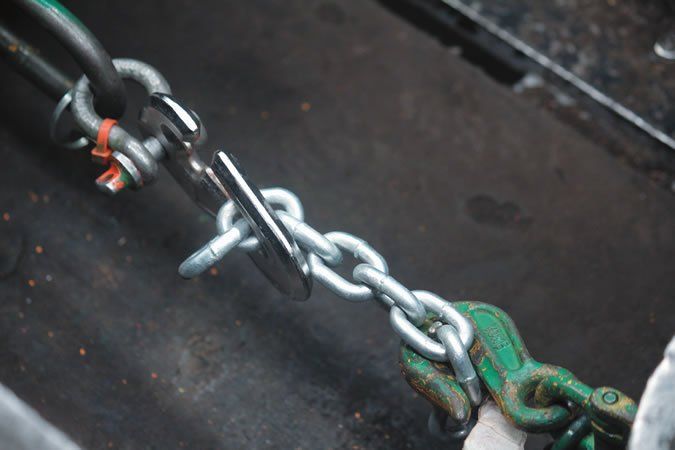During our research, nearly every maker of industrial chain offered the same caution: Using a generic chain hook can reduce the link strength by 20 to 25 percent. The generic style of chain hook, familiar to most sailors, resembles an elongated fish hook. As we found in this test, some other hook types are potentially more harmful.
Crosby, one of the worlds biggest suppliers of attachments for the lifting industry, offers a typical warning for its A-338 Clevis Grab Hook, nearly identical in design to those sold at chandlers. The use of A-338 Clevis Grab Hook will result in a 20-percent reduction in chain capacity.
Sadly, such cautions, conspicuous within the lifting industry, don’t make it into marine marketing materials. Hooks that don’t reduce a chains strength are commonly used in the lifting industry, but the most popular designs in the marine market can significantly impact chain strength under extreme loads.

Most boaters focus on the rated strength of the hook itself. Few, if any, realize that the $36 stainless chain hook they just bought might, under extreme loads, reduce the strength of their high-test G43 chain to the point that it is weaker than the less-expensive G30 chain.
Because of these concerns and others, we decided to test two off-the-shelf chain hooks of different designs. One hook came from Peerless Chain, a manufacturer of anchor chain and shackles that have performed well in previous PS tests (see PS January 2015 and August 2015 online). The Peerless hook is described as a G30 grab eye hook, and it comes in various sizes to fit most anchor chain. The 5/16-inch version (model 440242442) has a stated working load limit (WLL) of 1,900 pounds. The Mantus chain hook is slightly smaller, and is described as a quarter-inch chain hook that will also fit metric sizes of 6 to 7 millimeters; it also fit our 8-millimeter chain. The Mantus has a WLL of 2,600 pounds and a minimum breaking strength of 10,400 pounds.
For our test, we used a slightly undersized 8-millimeter (5/16-inch) chain that was compatible with the hook sizes. We chose used chain because it is representative of what is in use on many boats.
There was no doubt that the chain hooks reduced the chains strength. The original chain-without the hook-was tested and failed between the anchoring points; it broke at 6,274 pounds. With the Peerless hook, the chain failed at 4,849 pounds of load, representing a 22-percent reduction in strength, close to the lifting industry prediction of 20 to 25 percent. With the Mantus hook, the chain failed at 3,606 pounds of load, representing a 42-percent reduction in rode strength. Both chains failed at the hook. An examination of the Mantus chain hook shows that there is considerable opportunity for point loading. There are several other hooks on the market with a similar design, and their tightly radiused (sharp) edges will clearly impart point loading.
One unexpected observation regarding the Mantus hook was its low yield point, the point at which permanent deformation begins to occur. Given the hooks metallurgy and dimensions, we expected yield to begin around 5,200 pounds, but at 3,600 pounds of load, there was already serious deformation. The metal had obviously begun to yield at a lighter load. The Peerless hook did not deform at all during the test.
If any of these hooks are used with long snubbers, we see very little risk- the snubber absorbs the energy of any snatch load that might point-load the chain. However, if you use a short snubber, or low-stretch rope for your snubber, you could induce snatch loads approaching the chains true failure point.
For example,a typical 5/16-inch G30 chain has a minimum breaking strength of 7,600 pounds and an estimated 3,800-pound yield point (the point of permanent deformation). Assuming that using a chain hook reduces the strength in the hooked link by 42 percent (to 4,400 pounds), severe shock loads could approach the links yield point (now reduced to approximately 2,200 lbs.), deforming a link so that it wont fit in a windlass gypsy.
Keep in mind that even when weakened by a hook, the 5/16-inch G30 chains breaking strength is still 4,300 pounds. Unless the snubber breaks (not impossible), it is very unlikely that any chain with a snubber will be subjected to loads that high. But why risk it?
For a few dollars more, you can buy a chain hook that wont reduce the chain strength. We recently bought a quarter-inch cradle-style chain hook made of G70 that was certified to be used without any strength degradation of chain. It cost all of $5. It wasnt galvanized, but this shortcoming could be addressed. We sent ours to get it galvanized, but it would be interesting to see whether some DIY zinc coating could prevent corrosion. The three companies that rated well in our recent shackle test -Peerless, Crosby, and Campbell-all offer chain hooks of this type.




































